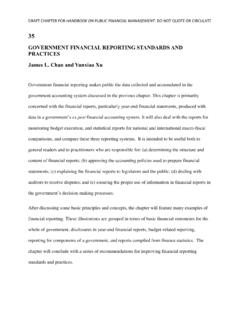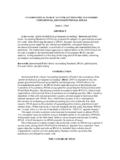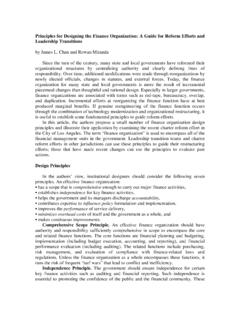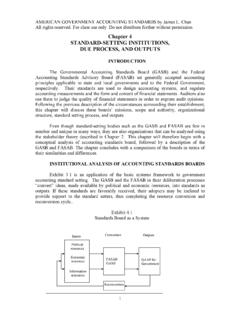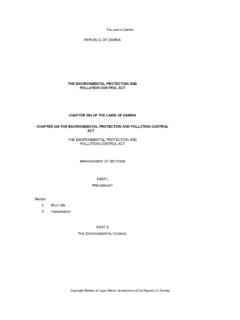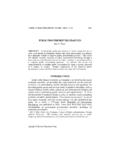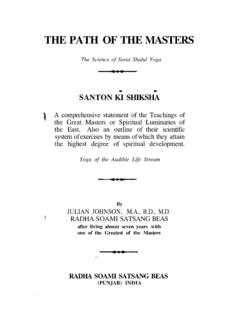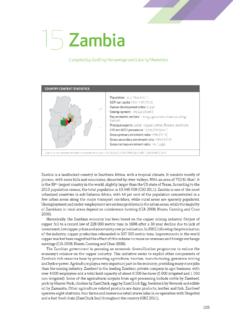Transcription of Chapter 3 The History of American Government …
1 American Government accounting STANDARDS by James L. Chan 1 Chapter 3 The History of American Government accounting reform INTRODUCTION The founding political philosophy and constitutional principles of Government accountability in the United States, largely unchanged in the past two hundred and thirty years, have served as the guiding light for the development of Government accounting . At the beginning of the 20th century, during the Progressive Era in American History , a good Government reform movement was launched. Many ideas were proposed and implemented to make Government work better and less corrupt.
2 Most of the modern ideas, upon closer examination, have their roots in that period. The historical account of American Government accounting reform experience is included in the present volume for both theoretical and practical reasons. The theoretical reason is that it provides evidence in support of the hypothesis that accounting is susceptible to environmental influences. While accountants hope that the information they produce can influence decisions and policies, at most this effect takes place at the organizational or micro level. In the larger scheme of things in a country or political system, accounting ideas and practices reflect more than affect political, economic and social change, at least in the short or intermediate term.
3 Nevertheless, through the process of slow accretion and aggregation over a long period of time, policies and practice that insist on accurate financial record-keeping, systematic financial management, and openness can with the reinforcement of favorable political and economic factors induce a culture of accountability and transparency. So the practical reason for recounting the American experience is to counsel patience and persistence: Government accounting reform cannot proceed faster than Government reform . This Chapter has two major sections.
4 The first sections describe three waves of Government accounting reforms in American state and local Government during the 20th century. The second section on the Federal Government describes the struggle between the legislative and executive branches over the power to set accounting rules and the eventual compromise, and the conflicts over the adoption of accrual accounting . The concluding section draws lessons from these historical experiences. American STATE AND LOCAL Government accounting REFORMS During the past hundred years, there have been three major waves of reforms aimed at transforming the way American state and local governments keep their accounts and report their financial affairs.
5 The first wave took place as an important part of the municipal Government reform during the Progressive Era at the dawn of the 20th century. The reformers saw better financial record-keeping as a way to fight corruption and make governments function more efficiently. During the second wave, from the 1930s to the mid-1970s, public finance professionals recommended uniform accounting principles primarily in support of systematic financial management. Finally, the third and current wave of reform has focused on making Government more accountable through greater transparency.
6 The significant features of these reforms are described in this section. American Government accounting STANDARDS by James L. Chan 2 Exhibit Milestones in State and Local Government accounting 1900 The National Municipal League established the Committee on Uniform accounting Methods. 1906 The National Association of Comptrollers and accounting Officers was established; its successors would sponsor Government accounting standard-setting bodies for almost eight decades. 1913 The New York Bureau of Municipal Research published The Metz Fund Handbooks of City Business Methods. 1934 The National Committee on Municipal accounting enunciated ten principles of Government accounting .
7 1968 The Municipal Finance Officers Association (MFOA) published Governmental accounting , Auditing and Financial Reporting. 1979 National Council on Governmental accounting issued Statement No. 1 Governmental accounting and Financial Reporting Principles . 1984 Governmental accounting Standards Board (GASB) was established. 1986 The American Institute of CPAs recognized GASB standards as generally accepted accounting Principles (GAAP). 1999 GASB Statement No. 34 requires Government -wide financial statements in addition to fund statements. First Wave of reform : Ensuring Financial Integrity During the Progressive Era, which lasted from the 1890s to around 1920, America changed from a rural community to an industrial society with growing urban populations.
8 Technical and managerial advances in transportation and communication led to the creation of large financial institutions and industrial and commercial corporations with a great demand for labor. Immigrants, mostly from Europe, flocked to American cities in large numbers. Municipal governments were under great pressure to provide basic public services. Existing institutions were inadequate to the task and corrupt Government officials engaged in grafts and filled Government jobs on the basis of personal connections rather than competence. As James Bryce, an astute British observer of American politics, said in 1891, The Government of [ American ] cities is one of the conspicuous failures of the United States.
9 Book titles such as The Shame of the Cities and Theft of the City reflect the sorry state of civic life. The morally upright and the economic elite demanded an end to official corruption, greater popular control over Government , and the expansion of Government services to cope with the rising demands of urban residents. As Government expenditures increased, so did taxes. As political and social reformers fought against corruption and injustice, businessmen motivated by enlightened self-interest sought greater economy and efficiency in Government , because they feared that without reform higher taxes would simply feed the bureaucracy staffed by the patronage system.
10 Business trade associations began a campaign for efficiency and economy in Government . Based on their own experience, these businessmen believed that sound business practices and good accounting would be essential for better Government . American Government accounting STANDARDS by James L. Chan 3 They attracted idealistic members of the American accounting profession to improve the accounting practices of municipal governments. The most concerted and influential efforts took place in New York City, where the city comptroller is an elected position. City Comptroller Herman Metz, a former businessman, introduced business practices and accounting procedures in city Government .
